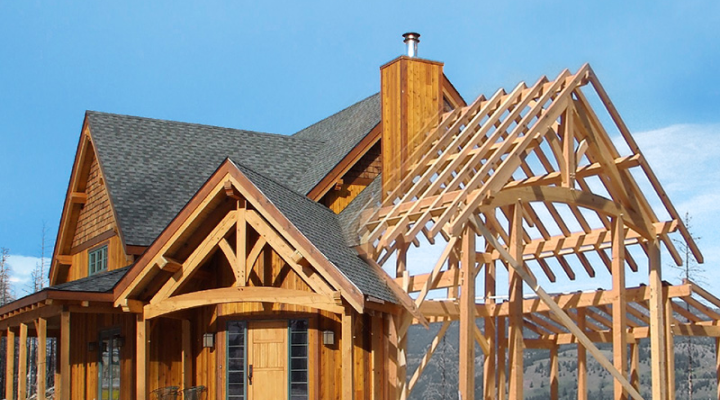
The popularity of commercial timber frame buildings has continued to increase in recent years. That’s led to increasing demand and some new timber frame design trends worth paying attention to.
Let’s look at some of these trends and how they might impact commercial developments moving forward. If you have questions about utilizing any of these trends in your own timber frame commercial buildings, please contact us.
What Are the Top Design Trends Shaping Commercial Timber Frame Buildings Today?
For a building process with such a long history, there are a surprising number of notable timber frame commercial building trends right now. Some of these include:
Mass Timber Materials
The timber framing construction industry is utilizing more engineered wood products, including:
- CLT: Cross-laminated timber is created by stacking layers of lumber with their grain oriented in a crosshatch pattern and bonding them under pressure. This process results in an exceedingly strong and stable finished product.
- Glulam: Glued laminated timber is created by bonding layers of timber together with moisture-resistant adhesive in the same directional orientation. This yields a product that has high strength and stiffness, excellent for spanning large gaps.
Hybrid Timber and Steel Systems
Building with timber and steel gives you the benefits of both materials, which can help make up for some of the drawbacks of each.
How do hybrid systems benefit commercial builds? Timber gives natural beauty and warmth to a structure while steel provides additional structural support and corrosion resistance. This hybrid approach can help lower long-term maintenance costs and improve performance against earthquakes.
Off-Site Modular and Prefabricated Construction
Using off-site manufacturing techniques allows for better precision in timber framing and much faster on-site assembly. Fit can be verified at the factory, so erection becomes very fast once the kit arrives at the building site. Prefabricated construction is even faster, arriving fully built.
Integration of AI and Smart Building Technologies
If you are wondering what innovations are improving speed and efficiency in timber construction, AI and smart building tech are the answers. These technologies are making it much faster to generate structural timber designs. They are also improving the manufacturing process by helping reduce wood waste.
Growth of Exposed Wood Elements in Modern Aesthetics
Modern aesthetics are adopting more exposed wood elements, which has led to an even greater interest in timber frame construction. The demand for natural materials and the warmth of timbers in modern designs continues to increase and shows no signs of stopping. What customers want, they tend to get, which has contributed to more demand for structural timber construction in commercial spaces.
Aligning with Modern Construction Goals
There are always new challenges in commercial construction. The way builders meet those challenges often combines tried and true practices, like structural timber and post and beam methods, with modern technologies like AI and smart fabrication tools. Right now, timber framing offers builders benefits like:
Sustainability
The demand for sustainable building practices grows every year. Some are driven by client demand, while some also result from increasing material costs and other challenges. The more sustainable you can make your building process, the better for you and your clients.
How are sustainability and carbon reduction influencing timber frame design? Timber has always been a sustainable building material. It captures carbon and is renewable, which makes it quite appealing in today’s market. But developments like AI improvements to wood waste production have made it even greener than it was before. You won’t find a material with a better rating for sustainability than properly sourced timber.
Fast Construction
Materials are costly, but labor is even more expensive. Clients are on tighter timelines as well, which puts pressure on builders to do more with less time. These pressures are unlikely to change anytime soon. Fortunately, the trends in timber frame construction are helping to address some of these challenges by making construction faster.
Prefab timber frames can be assembled at the building site in record time and with minimal manpower. This rapid construction helps reduce labor costs because it happens faster and with fewer workers than most other types of construction. The increased speed also makes it easier to meet client timelines. If they want a fast build, you can recommend structural timber and meet or exceed their expectations.
Improved ROI
Timber frame construction was already a good investment for many commercial applications. While the initial material costs could be higher, the long-term value of the structure was typically higher than with many cheaper construction methods. But with these new trends, you can build faster and cheaper than ever. That yields better ROI, which is certainly better for your bottom line.
Learn More About the Latest Timber Frame Design Trends
Every year, new trends emerge and new opportunities arise in timber frame construction. You don’t have to keep up with all of these trends on your own, though. That’s one of the many areas we specialize in at Hamill Creek. We are your timber frame experts.
Partner with the professional timber frame builders at Hamill Creek to bring your next commercial building to life with smart, sustainable, and lasting design.
Blog Archive / Holistic Living: Timber Frame Home Design for Wellness